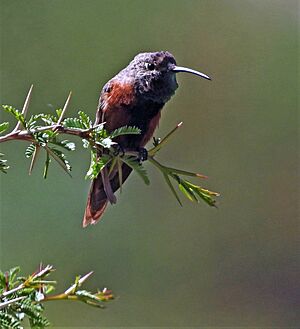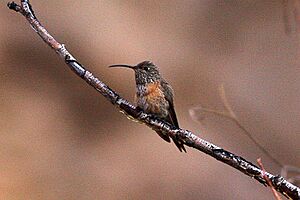Wedge-tailed hillstar facts for kids
Quick facts for kids Wedge-tailed hillstar |
|
|---|---|
 |
|
 |
|
| Male above, female below | |
| Conservation status | |
| Scientific classification | |
| Genus: |
Oreotrochilus
|
| Species: |
adela
|
 |
|
| Distribution in South America (green) | |
The wedge-tailed hillstar (Oreotrochilus adela) is a special kind of hummingbird. It belongs to a group of hummingbirds called "coquettes." You can find this amazing bird living in the high mountains of Argentina and Bolivia.
Contents
Meet the Wedge-Tailed Hillstar
The wedge-tailed hillstar is a unique bird. It is the only species in its specific group of hummingbirds. This means it doesn't have any very close relatives that are also called "wedge-tailed hillstars."
What Does It Look Like?
This hummingbird is about 11 to 13 centimeters (4 to 5 inches) long. It weighs around 7 to 8 grams, which is about as much as two pennies! Both male and female birds have a black beak that curves slightly downwards. Their upper bodies are gray-brown with a shiny, bronze look.
The male wedge-tailed hillstar is quite striking. It has a bright, sparkling green patch on its throat, called a gorget. Its belly is a warm chestnut color with a bold black stripe down the middle. Its tail is mostly blue-black, but the feathers on the sides have cinnamon-colored insides.
The female looks a bit different. Her throat is white with small gray and green spots. The rest of her belly is a pale reddish-brown. Her tail is also blue-black, but the tips of the outer feathers are white. Young birds look similar to the adult female.
Where Do They Live?
The wedge-tailed hillstar lives in the Andes mountains. You can find them from the southern part of the La Paz Department in central Bolivia, all the way south into the Jujuy Province in northwestern Argentina.
They prefer areas that are semi-dry or sometimes humid. These birds live below the very high puna grasslands. They often hang out among shrubs and in valleys where Polylepis trees grow. They can even live in areas where the habitat has changed, as long as there are still Dodonaea bushes, taller shrubs, and tall, thin cacti. These hummingbirds live at high elevations, from about 2,600 to 4,000 meters (8,500 to 13,000 feet) above sea level.
How Do They Live?
Movement and Travel
Scientists don't know a lot about how far wedge-tailed hillstars travel. However, they think these birds move around locally and might spread out to new areas.
What Do They Eat?
Wedge-tailed hillstars mostly drink nectar from flowers. They love flowers from plants like Barnadesia, Mutisia, and Puya. They also feed on different types of mistletoe and tall cacti. Besides nectar, they also eat small insects.
Reproduction and Life Cycle
The breeding season for the wedge-tailed hillstar isn't perfectly clear, but it seems to be from October to about February. During this time, male birds try to attract females. They do this by singing from a high spot and flying in a deep U-shape in the air.
The nest of a wedge-tailed hillstar is a large cup shape. It's usually stuck onto a rock face. Not much else is known about how these birds raise their young.
Sounds They Make
The male wedge-tailed hillstar has a special song it sings to attract a mate. It's a mix of fast, chattering notes. These notes are broken up by a clear sound that goes lower and lower.
Conservation Status
The IUCN (International Union for Conservation of Nature) keeps track of how many animals are left in the wild. They first thought the wedge-tailed hillstar was "Near Threatened." But in 2021, they changed its status to "Least Concern." This means they are not as worried about this bird becoming endangered right now.
There are an estimated 2,500 to 10,000 adult wedge-tailed hillstars. However, their numbers are thought to be slowly going down. Even though they are not very common, they can still live in areas where the land has been changed by humans, as long as there are still bushy ravines. There are many people living in the areas where these birds are found, and there aren't many protected areas for them.


